Our recent battle with COVID-19 and forced isolation had at least one bright side. The sales of all manner of recreational vehicles went through the roof. People who couldn’t vacation the usual way sometimes purchased a camper and headed for the great outdoors to reconnect with nature. This exodus to campgrounds was good for all involved, but it wasn’t without precedent. This 1969 Dodge 200 pickup with an Overland slide-in camper for sale on Facebook Marketplace in Medina, Ohio is a reminder of when camping was last so popular. This very neat truck and camper combo runs and drives, and is being offered for $18,000. Is this the kind of vintage rig you want to camp out of? Thanks to Ted for the cool find!
The history of the recreational vehicle and the automobile go together like peas and carrots. Once vehicles got to the point that they could carry or tow a bit more weight, people began dreaming up ways to use their vehicles to get to the great outdoors. From the Tin Can Tourists with their homemade campers to Henry Ford, Thomas Edison, Harvey Firestone, and the rest of the crew who called themselves “The Vagabonds” venturing out to camp with their army of support vehicles and a platoon of help, the early years of vehicle-based camping were fun and pioneering to a degree. When the Depression and the Dust Bowl hit, car camping took on a more desperate tone. There is a fine line between camping and homelessness, and many of our fellow Americans were on the wrong side of it.
The thirties and forties brought with them hard-sided camping trailers. While the Depression hampered sales and, thus, the development of such vehicles, World War II was the primary contributing factor to their explosion of popularity. During the war, they were purchased to make up for a shortage of base housing. After the war, returning GIs purchased them to live in while the housing market struggled to meet the insane postwar demand. Building these trailers also provided work for factories suddenly without war-related work. The fifties and sixties saw these trailers evolve into more portable living quarters for families who wanted to travel from place to place with their families. During this decade, some folks decided to skip the trailer and drive their camper to their destination. One of the most famous companies that built these rolling houses was Winnebago.
The late sixties and early seventies brought with them an explosion of interest in smaller camping trailers and slide-in truck campers along with more evolved traditionally sized travel trailers and motor homes. Companies that made conventional pickups catered to the slide-in camper market by offering “camper specials.” These camper specials provided standard features tailored for this market such as heavy-duty frames and suspensions, larger engines, long bed lengths, and some even relocated the spare tire to the side of the bed for convenience. Having a slide-in meant that you could use your truck during the week, back under your new camper that was suspended on jacks in your yard, and enjoy the weekend with your family and friends in a very confined space. These setups were common for a long time mainly due to their convenience. However, rising fuel prices and the economic downturn in the seventies made them a rarity by the end of that decade.
Finding a slide-in camper from this era is rare. Campers of all types tend to age in dog years. The necessity for a low overall weight, the flexing that they take when moving down the road, and an internal structure that is nearly always untreated pine boards in small sizes don’t help recreational vehicles of all types last for long. Rain always seems to find its way in, and the rot caused by it is hard to repair. This 1969 Dodge 200 truck and its Overland slide-in camper have somehow managed to survive long after so many other campers of this type have returned to the Earth via the nearest landfill by living a life in the dry, western part of the country. The camper, which was stored indoors, is a 1968 model, and the picture above shows its incredibly good condition. It is also a good example of how these companies managed to use every square inch of space effectively. For example, the dining table can be removed from the side and reinserted between the seats to make a foundation for another bed.
As for the truck, it is pretty unique as well. The seller tells us that it is a 200-series camper special. It has a 318 cubic inch V-8 under the hood with an automatic transmission. At some point, the engine was updated with an aluminum intake and an Edelbrock carburetor, with a Flowmaster setup handling the exhaust. This new equipment stands in contrast to the AM radio, CB radio, and vintage aftermarket air conditioning system we see in the interior picture posted above. The seller claims that you can jump in it and travel today.
What would you do with such a rig besides camp to your heart’s content in late sixties style? There is currently a subculture in the world of classic vehicles that centers around vintage campers and the experience of camping with them. Nearly all of them use travel trailers. Showing up in a slide-in rig such as this one would be pretty fun. Thousands of Americans enjoyed owning campers such as this during a great time in our country’s history for gearheads. It would be nice to see one of these rare recreational vehicles prowling the roads again.
Have you ever owned a slide-in camper? What was it like camping in it? Please share your memories in the comments.

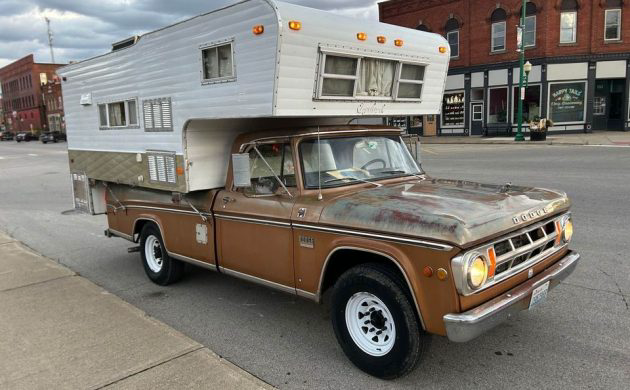
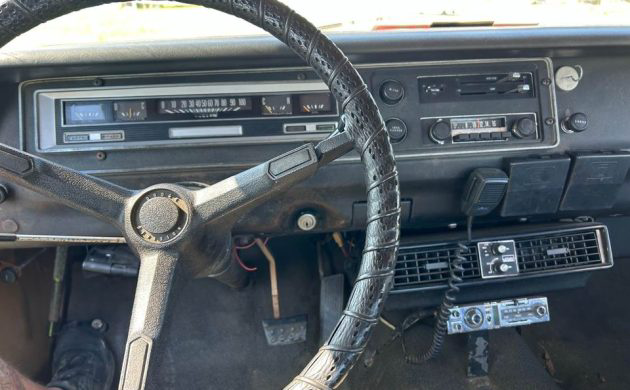
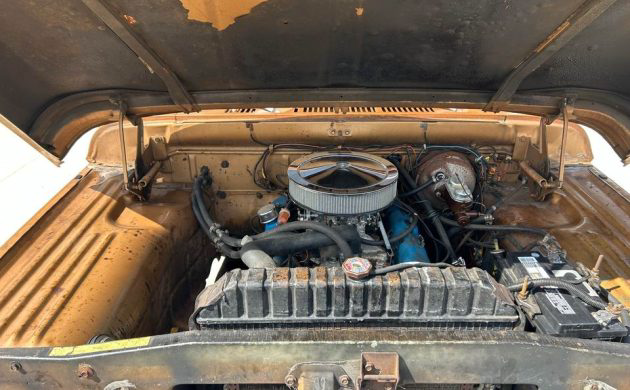
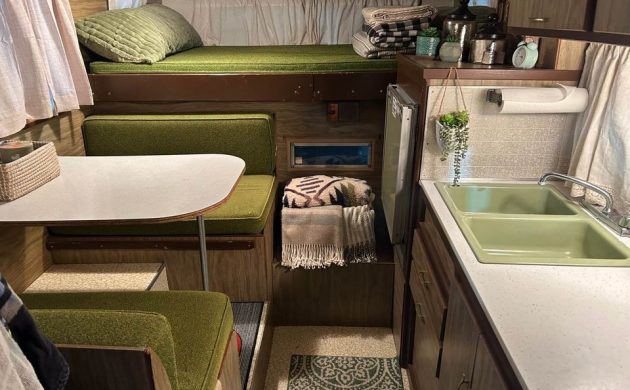
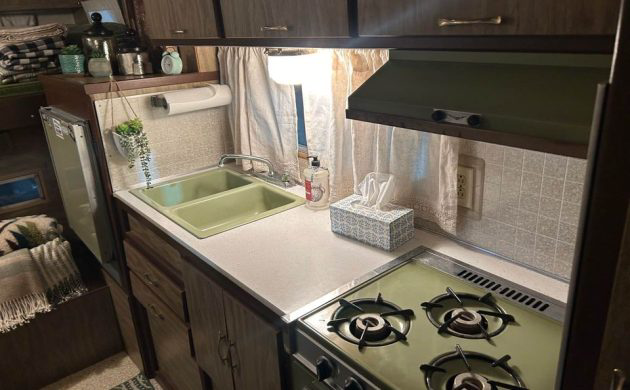


The truth is one of those campers should be in a one ton truck. The 3/4 ton is very likely overloaded. Look at how low the back end sits. My Dad had one on a 3/4 ton 1980’s Chevy truck, I had to add overload springs to make it sit close to level. A friend (Police Chief) who had one told me that if you weigh it, you can expect at least 800 Lb. overweight.
Our own Scotty G. literally grew up in one of these, only a Ford. Those travels, whether he likes to admit it or not, cemented his love of driving( or dislike for flying) and puts on a lot of miles. His dad must have been a good example.
I go back and forth what to do. Just when I get a wild hair up the touchas to do more traveling in my old age, one conversation with Scotty puts that to rest in a hurry. Oh sure, sitting at the kitchen table, what a wonderful world,,,in reality, traveling by car sucks. Scottys travels are littered with tense situations, I don’t know how he does it. Perhaps it’s my history of driving so much, my patience is worn to a frazzle. Why, I get upset if I miss 1 of the 3 stoplights in town on the way to Walmart.
HOWEVER,,, with long trips off the table, a unit like this could work for short rides, and sit for a week. It’s incredibly unstable, aerodynamics of a box and ensuing gas mileage of one, those cross winds will negate a trip to Walmart for new undies, but for what it is, you get both worlds, camper and cool vintage pickup, the attraction of slide ins all along. I read, a typical pull behind trailer in 1970 cost about $1,700 bucks. A slide in was half that, and they sold a million of them. It’s a great find, another of “dads truck” surplus. Camping today is full tilt, ultimate behemoths pulled by semi-like trucks, not sure the interest is there for this. It’s not listed so someone got a nice rig.
I really like that old Dodge. The camper is cool, but I doubt I’d use that much. Maybe if you lived near Yellowstone – I could see that being an awesome way to see the entire park – just driving around inside the park – not actually cross country to the park, mind you.
I know this truck is supposed to be a heavier duty “camper special”, but it sure looks like that camper is squatting the rear of the truck already. I can imagine a wallowy, weaving ride with the headlights spotlighting coons at night.
I like that Yellowstone idea, though. Just don’t get in a hurry.
Wow, Jeff, great article! Appreciated learning more about the American camping phenomenon. Great rig too.
I had an 1973 F250 camper special w/ an 11.5 ft Coachman slide in camper, loved that rig had it for 9years traveled all over the east coast Maine to Flordia , 10 mpg on a good day, equipped with 2 fuel tanks for a reason , had the 390 c6 transmission 16.5 tires 10 ply , never let me down in over 105 miles , lots of good times . had a friend that had a Dodge like this it also was a good vehicle ! hope someone gets this and enjoys it!
I too grew up in one of these. My dad hauled it on a 65 Ford F250. It was still around when I had kids so I bought it. Hauled it on a 77 Ford F250. Lots of good memories there.
My parents always had campers on the back of Ford’s & GMC heavy duty 3/4 ton trucks.
I always preferred sleeping in a pup tent as a kid, but enjoyed these units when the weather was poor.
We traveled most of the US of A and Canada when I was at home.
Great memories.